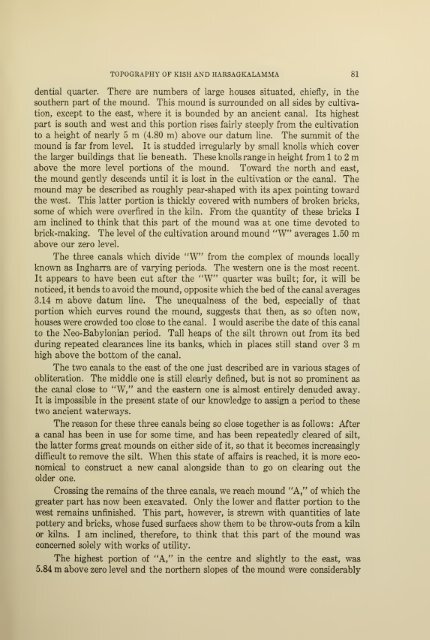A Sumerian Palace and the "A" cemetery at Kish, Mesopotamia
A Sumerian Palace and the "A" cemetery at Kish, Mesopotamia
A Sumerian Palace and the "A" cemetery at Kish, Mesopotamia
You also want an ePaper? Increase the reach of your titles
YUMPU automatically turns print PDFs into web optimized ePapers that Google loves.
TOPOGRAPHY OF KISH AND HARSAGKALAMMA 81<br />
dential quarter. There are numbers of large houses situ<strong>at</strong>ed, chiefly, in <strong>the</strong><br />
sou<strong>the</strong>rn part of <strong>the</strong> mound. This mound is surroimded on all sides by cultiva-<br />
tion, except to <strong>the</strong> east, where it is bounded by an ancient canal. Its highest<br />
part is south <strong>and</strong> west <strong>and</strong> this portion rises faii'ly steeply from <strong>the</strong> cultiv<strong>at</strong>ion<br />
to a height of nearly 5 m (4.80 m) above our d<strong>at</strong>um line. The summit of <strong>the</strong><br />
mound is far from level. It is studded irregularly by small knolls which cover<br />
<strong>the</strong> larger buildings th<strong>at</strong> lie bene<strong>at</strong>h. These knolls range in height from 1 to 2 m<br />
above <strong>the</strong> more level portions of <strong>the</strong> mound. Toward <strong>the</strong> north <strong>and</strong> east,<br />
<strong>the</strong> mound gently descends until it is lost in <strong>the</strong> cultiv<strong>at</strong>ion or <strong>the</strong> canal. The<br />
mound may be described as roughly pear-shaped with its apex pointing toward<br />
<strong>the</strong> west. This l<strong>at</strong>ter portion is thickly covered with numbers of broken bricks,<br />
some of which were overfired in <strong>the</strong> kiln. From <strong>the</strong> quantity of <strong>the</strong>se bricks I<br />
am inclined to think th<strong>at</strong> this part of <strong>the</strong> mound was <strong>at</strong> one time devoted to<br />
brick-making. The level of <strong>the</strong> cultiv<strong>at</strong>ion around mound "W" averages 1.50 m<br />
above our zero level.<br />
The tliree canals which divide "W" from <strong>the</strong> complex of mounds locally<br />
known as Ingharra are of varying periods. The western one is <strong>the</strong> most recent.<br />
It appears to have been cut after <strong>the</strong> "W" quarter was built; for, it will be<br />
noticed, it bends to avoid <strong>the</strong> mound, opposite which <strong>the</strong> bed of <strong>the</strong> canal averages<br />
3.14 m above d<strong>at</strong>um line. The unequalness of <strong>the</strong> bed, especially of th<strong>at</strong><br />
portion which curves round <strong>the</strong> mound, suggests th<strong>at</strong> <strong>the</strong>n, as so often now,<br />
houses were crowded too close to <strong>the</strong> canal. I would ascribe <strong>the</strong> d<strong>at</strong>e of this canal<br />
to <strong>the</strong> Neo-Babylonian period. Tall heaps of <strong>the</strong> silt thrown out from its bed<br />
during repe<strong>at</strong>ed clearances line its banks, which in places still st<strong>and</strong> over 3 m<br />
high above <strong>the</strong> bottom of <strong>the</strong> canal.<br />
The two canals to <strong>the</strong> east of <strong>the</strong> one just described are in various stages of<br />
obliter<strong>at</strong>ion. The middle one is still clearly defined, but is not so prominent as<br />
<strong>the</strong> canal close to "W," <strong>and</strong> <strong>the</strong> eastern one is almost entirely denuded away.<br />
It is impossible in <strong>the</strong> present st<strong>at</strong>e of our knowledge to assign a period to <strong>the</strong>se<br />
two ancient w<strong>at</strong>erways.<br />
The reason for <strong>the</strong>se three canals being so close toge<strong>the</strong>r is as follows: After<br />
a canal has been in use for some time, <strong>and</strong> has been repe<strong>at</strong>edly cleared of silt,<br />
<strong>the</strong> l<strong>at</strong>ter forms gre<strong>at</strong> mounds on ei<strong>the</strong>r side of it, so th<strong>at</strong> it becomes increasingly<br />
difficult to remove <strong>the</strong> silt. Wlien this st<strong>at</strong>e of affairs is reached, it is more eco-<br />
nomical to construct a new canal alongside than to go on clearing out <strong>the</strong><br />
older one.<br />
Crossing <strong>the</strong> remains of <strong>the</strong> three canals, we reach mound "A," of which <strong>the</strong><br />
gre<strong>at</strong>er part has now been excav<strong>at</strong>ed. Only <strong>the</strong> lower <strong>and</strong> fl<strong>at</strong>ter portion to <strong>the</strong><br />
west remains unfinished. This part, however, is strewn with quantities of l<strong>at</strong>e<br />
pottery <strong>and</strong> bricks, whose fused surfaces show <strong>the</strong>m to be throw-outs from a kiln<br />
or kilns. I am inclined, <strong>the</strong>refore, to think th<strong>at</strong> this part of <strong>the</strong> moimd was<br />
concerned solely with works of utility.<br />
The highest portion of "A," in <strong>the</strong> centre <strong>and</strong> slightly to <strong>the</strong> east, was<br />
5,84 m above zero level <strong>and</strong> <strong>the</strong> nor<strong>the</strong>rn slopes of <strong>the</strong> mound were considerably

















